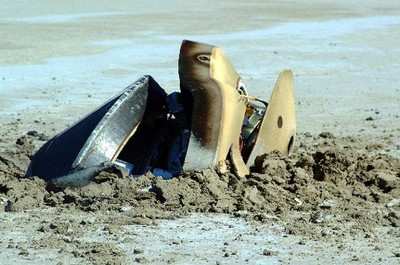Sun, Sep 19, 2004
But It's Looking Good...
Genesis team scientists and engineers continue their work on the
mission's sample return canister in a specially constructed clean
room at the US Army Proving Ground in Dugway (UT). As more of the
capsule's contents are revealed, the team's level of enthusiasm for
the amount of science obtainable continues to rise.

Right now, the science canister that holds the majority of the
mission's scientific samples is lying upside down - on its lid.
Scientists are very methodically working their way "up" from the
bottom portion of the canister by trimming away small portions of
the canister's wall. The team continues to extract, from the
interior of the science canister, small but potentially analyzable
fragments of collector array material. One-half of a sapphire wafer
was collected Tuesday - the biggest piece of collector array to
date.
The mission's main priority is to measure oxygen isotopes to
determine which of several theories is correct regarding the role
of oxygen in the formation of the solar system. Scientists hope to
determine this with isotopes collected in the four target segments
of the solar wind concentrator carried by the Genesis spacecraft.
The condition of these segments will be better known over the next
few days, after the canister's solar wind concentrator is
extricated. At this time, it is believed that three of these
segments are relatively intact and that the fourth may have
sustained one or more fractures.

There are no concrete plans regarding the shipping date of the
Genesis capsule or its contents from Dugway to the Johnson Space
Center in Houston. The team continues its meticulous work and
believes that a significant repository of solar wind materials may
have survived that will keep the science community busy for some
time.
The Genesis sample return capsule landed well within the
projected ellipse path in the Utah Test and Training Range on Sept.
8, but its parachutes did not open. It impacted the ground at
nearly 320 kilometers per hour (nearly 200 miles per hour).
More News
Aero Linx: Model Aeronautical Association of Australia MAAA clubs are about fun flying, camaraderie and community. For over 75 years, the MAAA has been Australia’s largest fl>[...]
Touchdown Zone Lighting Two rows of transverse light bars located symmetrically about the runway centerline normally at 100 foot intervals. The basic system extends 3,000 feet alon>[...]
“Discovery and innovation are central to our mission at Virgin Galactic. We’re excited to build on our successful record of facilitating scientific experiments in subor>[...]
How To Get A Story On Aero-TV News/Feature Programming How do I submit a story idea or lead to Aero-TV? If you would like to submit a story idea or lead, please contact Jim Campbel>[...]
Student Pilot Reported That During Rotation, “All Of A Sudden The Back Of The Plane Kicked To The Right..." Analysis: The student pilot reported that during rotation, “>[...]
 ANN's Daily Aero-Linx (05.02.24)
ANN's Daily Aero-Linx (05.02.24) ANN's Daily Aero-Term (05.02.24): Touchdown Zone Lighting
ANN's Daily Aero-Term (05.02.24): Touchdown Zone Lighting Aero-News: Quote of the Day (05.02.24)
Aero-News: Quote of the Day (05.02.24) ANN FAQ: Contributing To Aero-TV
ANN FAQ: Contributing To Aero-TV NTSB Final Report: Cirrus Design Corp SR20
NTSB Final Report: Cirrus Design Corp SR20




